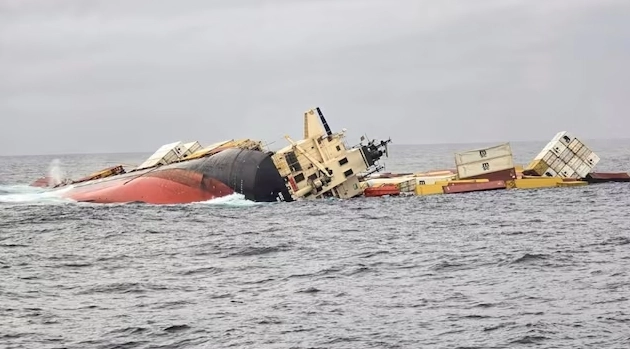
The sinking of a cargo ship near the Kerala coast on May 25 has raised environmental concerns due to its oil and chemical spill.
On May 25, Liberian cargo ship MSC ELSA 3, carrying 643 containers—including 13 with hazardous materials—capsized 14.6 nautical miles from Thottappally harbour in Alappuzha, Kerala. The vessel released substantial quantities of diesel and oil into the Arabian Sea, along with hazardous chemicals like calcium carbide. All crew members were safely rescued.
“The three crew have been recovered by INS Sujata, under dangerous circumstances as some more containers have fallen into water and the vessel is further submerged", a Defence PRO said on Sunday morning.
How Did The Ship Sink?
According to the Indian Coast Guard (ICG), the MSC ELSA 3 vessel capsized rapidly in the early hours of Sunday “due to flooding in one of the holds". A hold is a section below deck where the cargo is stored.
“The vessel was carrying 640 containers, including 13 containing hazardous cargo and 12 with calcium carbide. Additionally, the ship had 84.44 metric tonnes of diesel and 367.1 metric tonnes of furnace oil in its tanks," the ICG said in a post on X.
The MSC ELSA 3 was a 184-meter-long container ship built in 1997 and operated by the Mediterranean Shipping Company (MSC). It had a crew of 24, comprising one Russian (the captain), 20 Filipinos, two Ukrainians, and one Georgian.
What Is An Oil Spill?
An oil spill is an accidental release of petroleum products such as crude oil, diesel, or fuel oil into the environment, typically water bodies such as oceans, rivers or coastal areas.
Oil spills often happen due to ship accidents, offshore drilling, pipeline leaks or illegal dumping or operational discharges from vessels.
When oil spills into water, it rapidly spreads. Due to its lighter density, it forms a layer over water, obstructing sunlight and disrupting photosynthesis in marine plants.
What Is The Environmental Impact Of Oil Spills?
The immediate aftermath of an oil disaster has effects on fish, sea birds, and other marine animals. Coated in oil, animals can be killed by poisoning or suffocation.
Ecological Damage: Oil can also affect food sources for sea life, making it less available or of poorer quality, so even animals that survive the initial environmental hazards may still suffer in the weeks and months following the leak. Oil coats marine animals (birds, fish, mammals), disrupting breathing, movement, and thermoregulation. It’s toxic if ingested, damaging organs and reproduction.
Ecosystems: Coral reefs, mangroves, and coastal habitats like Kerala’s biodiversity-rich shores can suffer long-term damage. Oil smothers plants and disrupts food chains. Oil impacts breeding and reproduction, for example contaminating bird or turtle nests on shore, affecting viability, and suffocating unhatched chicks.
Water Contamination: Oil residues persist, affecting water quality and aquatic ecosystems.
Economic Consequences: Fishing bans, like those imposed post-MSC ELSA 3, harm livelihoods. Kerala’s fishing communities could face immediate income loss.
Tourism: Oil-stained beaches deter tourists and impact coastal economies.
Clean-up Costs: Clean-up efforts, like those by the Indian Coast Guard using dispersants and booms, are expensive and time-consuming.
Human Health: Exposure to oil vapours or contaminated seafood can cause respiratory issues, skin irritation, or long-term health risks.
What Are The Biggest Oil Spills In History?
Here are some of the biggest and most devastating oil spills in history, ranked by the volume of oil spilt and their environmental impact:
Deepwater Horizon (Gulf Of Mexico, April 20-July 15, 2010): Nearly 206 million gallons, that is, 4.9 million barrels, were spilt into the water after the BP-operated Deepwater Horizon offshore drilling rig exploded, killing 11 workers and releasing oil from an underwater well for 87 days. It remains the largest accidental marine oil spill in history. It devastated Gulf Coast ecosystems, killing thousands of marine animals (e.g., dolphins, turtles), destroying fisheries, and affecting tourism in Louisiana, Mississippi, and Florida. Clean-up costs exceeded $65 billion, with BP paying $20.8 billion in settlements.
Gulf War Oil Spill (Persian Gulf, January 19-28, 1991): Iraqi forces deliberately released oil from Kuwait’s Sea Island terminal and tankers during the Gulf War to hinder US military operations. Nearly 240-336 million gallons, that is, 6-8 million barrels, were spilt into the war. It is the largest intentional oil spill ever.
Ixtoc I (Gulf of Mexico, June 3, 1979–March 23, 1980): A blowout at the Pemex-operated Ixtoc I offshore well off Mexico’s Yucatán Peninsula released 140 million gallons, nearly 3.3 million barrels, of oil for 10 months, the longest continuous spill until Deepwater Horizon.
Atlantic Empress (Off Tobago, July 19, 1979): The Greek tanker Atlantic Empress collided with another ship, Aegean Captain, off Trinidad and Tobago, spilling crude oil that was estimated 88 million gallons. Both ships caught fire, and 27 crew members died. Much of the oil was burned or dispersed in the open ocean, reducing coastal damage, but marine life was heavily affected.
Amoco Cadiz (Brittany, France, March 16, 1978): The Liberian-registered supertanker ran aground off Brittany during a storm, splitting apart and releasing its entire crude oil cargo. The 68.7 million gallons of oil spilt into the water, devastating 200 miles of French coastline, killing 20,000 seabirds and destroying oyster beds. The clean-up took months and cost around $100 million.